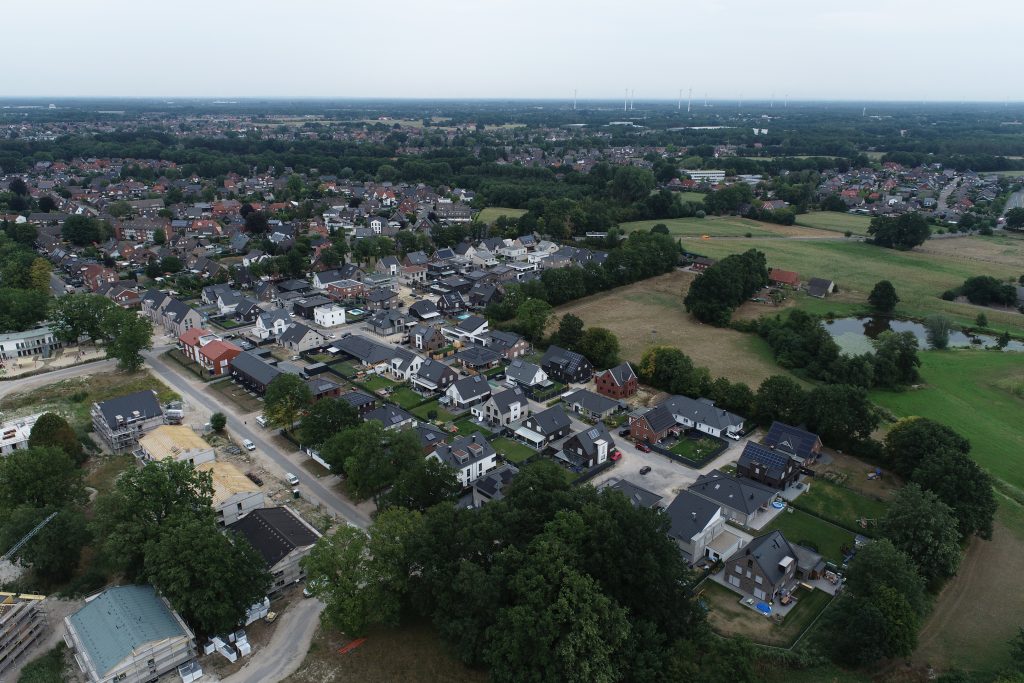Rheine. In September 2017, the former General Wever Barracks (GWK) and today’s “Eschendorfer Aue” was handed over to the city of Rheine by the Bundesanstalt für Immobilienaufgaben (BImA). Five years later, the last construction phase is about to be marketed.
What has happened in the past five years?
In October 2017, six weeks after GWK was taken over by the city, the first excavators rolled and the deconstruction of the 5.8-hectare eastern section began. In addition to massive concrete ramps and an almost complete sealing of the area, all buildings also had to be demolished. “By using the city’s surveying drone for the first time on a large construction site, we were able to accurately determine the various soil and demolition masses from the air and determine them for billing purposes,” explains project manager Mark Dieckmann.


In parallel, the development plan “Ostteil” and the new development were planned. After the deconstruction was completed after only six months, in April 2018, the new development could start immediately. Thus, the marketing of the first approx. 80 building plots took place only 14 months after the takeover of the property. The “run” on the first building plots of the most sought-after building area in Rheine and the surrounding area was enormous. There were more than 600 people interested in building on the list of interested parties at the municipal real estate office. The sales prices for the subsidized plots started at 109.50 € /m² (plus development costs of approx. 26 €/m²). “The development of the Eschendorfer Aue by the city was the right decision for the citizens. This has had a price-dampening effect on the land prices and thus affordable building land for young families has been created. The first builders already started at the beginning of 2019. In the meantime, the eastern part has been completely built on and the final road development is imminent,” explains Mayor Dr. Peter Lüttmann.
In January 2019, demolition began in the approximately 26-hectare western section. In total, a building mass on the scale of approximately 300 normal single-family houses has been demolished on the site. Especially the 24 massive air raid shelters, intended for about 2,000 soldiers, were a challenge even for the larger excavators. “The advantage was that we processed this high-quality concrete rubble on site in such a way that the material could be used almost completely for the new roads. This not only resulted in enormous cost savings, as no natural stone gravel had to be delivered for the new roads, but also saved many 1,000 truck trips,” Dieckmann continues.
Parallel to the deconstruction, the renaturation of the approx. 1 km long former piped watercourse 1100 started in the summer of 2019. For this purpose, approx. 14,000 m³ of soil were moved. Sophisticated soil management made it possible to achieve the goal of keeping all the excavated soil and the necessary soil movements on the site.
In the fall of 2019, the de-silting of the existing pond was on the agenda. Here, several 1,000 tons of sludge were taken out. Thus, in addition to absorbing rainwater, the pond can also serve local recreation and improve the microclimate.
After marketing the eastern part in the fall of 2018, the first construction phase in the western part with approx. 40 multi-family house plots could be marketed in the fall of 2019, following new development in the summer of 2019.
The deconstruction of the western part ended in the summer of 2020 and the II construction phase in the western part started in the fall of 2020.
During the peak of the project, in the summer of 2019, demolition, renaturalization work and new development at times involved 17 excavators and about 85 people working on the site. “If I wasn’t on the construction site for more than three days, I hardly recognized it,” smiles Mark Dieckmann.
In this system, the III construction phase was developed in the spring/summer of 2021 and marketed in the fall of 2021. Now, after completion of the development of the IV construction phase in 2022, the marketing of the last construction phase is scheduled for the end of 2022.
“We have kept our promise to complete one construction phase each year. In total, almost 300 single-family homes and more than 50 multi-family homes, living space for approximately 1,600 people, were and are being built in the Eschendorfer Aue,” adds Mayor Dr. Peter Lüttmann.
It has also been necessary to respond time and again to changing requirements and conditions: Deviating from the original planning, a second five-group kindergarten has now been built in the Eschendorfer Aue, which is expected to be in operation before the end of 2022. A generously equipped children’s playground is in the planning stage and will be realized in 2023.
“It should be emphasized that this project succeeded with the city administration’s own specialist departments and TBR, and that it did not require any additional hiring of personnel,” said Milena Schauer, head of the building department.
The city administration is equally proud that the Eschendorfer Aue has received the NRW 2021 Soil Protection Award and, at the invitation of the BImA, will present the successful conversion process in Rheine at the world’s largest real estate trade fair, EXPO REAL in Munich, on October 5, 2022.
Photo (City Press Office, EA East Part Stand 1August 2022): An aerial view shows the eastern part of the Eschendorfer Aue (as of August 2022).
Photo (City Press Office, EA
Photo (City Press Office, KiTa I): A second kindergarten has been built next to the existing KiTa and is expected to be operational by the end of the year.